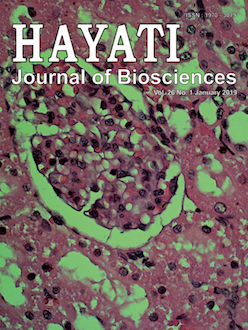Ground Vegetation Diversity on Different Type of Riverbank Along Ciliwung River in Bogor City, West Java
Abstract
Ciliwung riverbank has been affected by settlement occupation. Both concrete and another retaining wall system have been built to avoid flood and erosion to the settlement that has existed adjacent to the river. Built environment as human disturbance can trigger the change of species richness of ground vegetation in the Ciliwung riverbank of Bogor City. The research objective is to study the difference of ground vegetation biodiversity in three different types of riverbank based on its condition: natural, semi-natural, and constructed riverbanks. Point method and photographic sampling are used. Five replications of a square metre plot at three transects were placed at four sites sampling along 250 m each from the three different types of riverbank. Images of the plots are trained using sample point to overcome the difficulties in the field observation and statistical analysis. The result discovered that species richness in the natural riverbank is significantly higher than in semi-natural and constructed riverbank. Yet, no significance of species richness is shown between semi-natural and constructed riverbank. Total species of ground vegetation that we found were 55 species. Each different type of riverbank has its own highest species coverage: Asystasia nemorum (55.00%) in the natural riverbank, Pilea nummulariifolia (33.07%) in the semi-natural riverbank, and Pogonatherum crinitum (52.80%) in the constructed riverbank. The study concluded that the construction in the riverbank largely altered the biodiversity of ground vegetation in the urban riverbank. The outcomes suggest that the remnant of natural riverbank in the urban landscape should be highly protected from urban development to preserve its biodiversity. Also, species found could be potentially developed as landscape plants to support urban river planning, design, and management.
Downloads
HAYATI J Biosci is an open access journal and the article's license is CC-BY-NC. This license lets others distribute, remix, tweak, and build upon author's work, as long as they credit the original creation. Authors retain copyright and grant the journal/publisher non exclusive publishing rights with the work simultaneously licensed under a https://creativecommons.org/

























.png) IPB University
IPB University Department of Biology
Department of Biology The Indonesian Biological Society
The Indonesian Biological Society 

